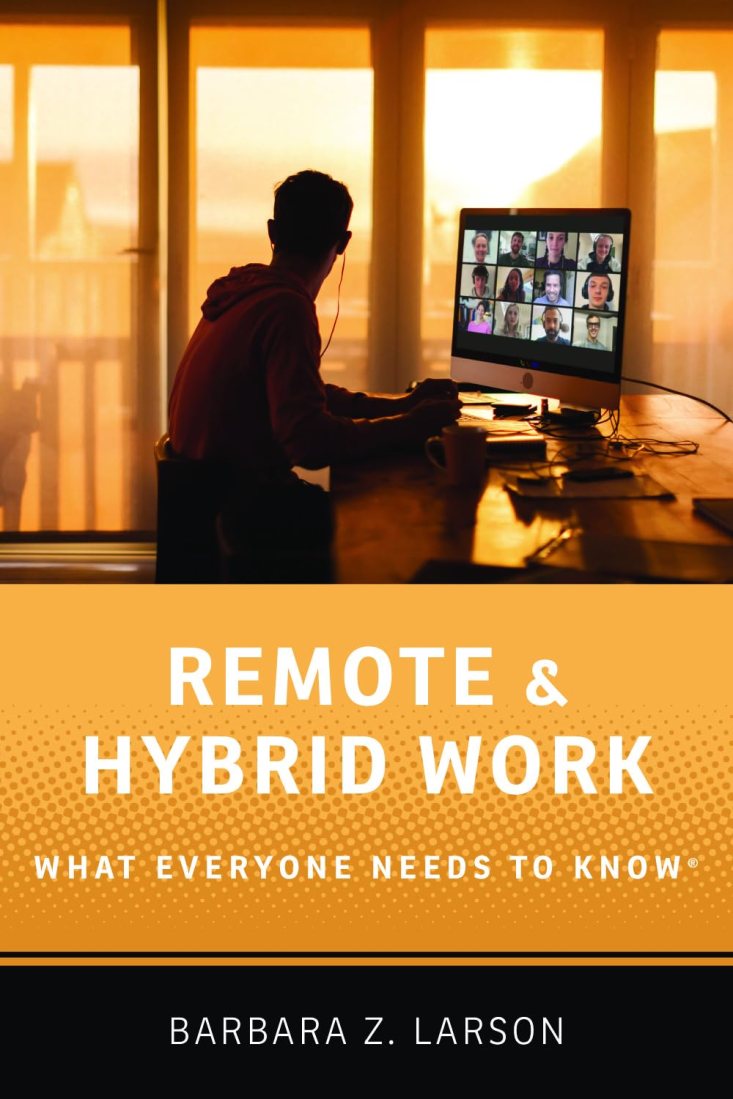Remote work isn’t new, Barbara Larson says, and it isn’t going away.
Larson, who is an executive professor of management and organizational development at Northeastern University, has published a new book called “Remote and Hybrid Work: What Everyone Needs To Know.”
As the subtitle suggests, the book promises to address the concerns of the entire range of those affected by remote work, from “individuals who are engaging in any kind of virtual work,” she says, “to remote workers, to managers of remote workers, to [entirely] remote teams,” and on up through company policy and governmental approaches.
While remote work suddenly arrived on the broad culture’s mind in March 2020 with the COVID-19 lockdown, Larson has been studying remote work for the past 10 years, and her interest in it stretches back even further.

“Back in the late ’80s,” she says, “my first real job was working at Hearst Magazines in New York.” Working in the trademark licensing department, Larson noticed that many of her relationships with co-workers were virtual — “in the sense that they were mediated by technology,” she clarifies.
“There was no email at that point,” she says with a laugh. “We’re looking at fax machines.”
Nevertheless, what fascinated Larson was “how different relationship types developed over time in a virtual or remote setting and how the physical distance wasn’t necessarily a predictor of the quality of the relationship.”
Eventually — after an MBA and a career pivot — Larson arrived at Northeastern. During her first year, she was teaching a class on organizational behavior. “I thought, ‘I want to teach something about how to work when you’re not in the same place with somebody.’”
Now, with the prevalence of platforms like Skype, Zoom and Microsoft Teams, co-workers in different locations can seem commonplace. A decade ago, she says, the idea was almost comical.
When Larson went looking for teaching materials, however, she could find hardly any. “So then I went and looked at the research,” she goes on, “because that’s what you do when you’re a professor.”

While she found research on virtual work, “there was less than I would have expected,” she says.
Virtual work, she explains, effectively makes remote work possible. “If you send an email, you’re doing virtual work. If you call somebody on the phone, you’re doing virtual work. … I’m not the only one to have made this point, but virtual work has been around since the era of carrier pigeons.”
In 2013, Larson “held a little workshop at an organizational behavior teaching conference on teaching virtual work skills,” she says. There she met Erin Makarius, now an associate professor of management at the University of Akron, who was interested in the same subjects.
“I always love to say [that] my research agenda came out of a teaching conference. She and I were comparing notes and going, ‘Well, there’s not much out there.’”
Larson would eventually come to focus on “the individual experience of remote work.”
So, when it comes to working remotely, what do we need to know?
First, Larson notes, the majority of those who work remotely aren’t doing so full time — rather, most are hybrid workers who go into their place of business part time.
The number one piece of advice she gives these workers? Schedule intelligently.
By which she means the flexibility to design a schedule around a worker’s most productive times.
“It’s important,” she says, to have “individual focused work on the days when you’re home, and then schedule your collaborative work when you and your co-workers are in the office.”
“Otherwise it becomes this worst-of-all-worlds where you’re at home and you’re on Zoom all day instead of being able to focus on your work. And when you’re in the office, you’re in Zoom all day because your co-workers — the people that you need to meet with — aren’t in the office.”
While remote work can have tangible benefits for some — better work-life balance, depending on the individual, or increased flexibility for companies during extreme weather events — it also correlates with a higher difficulty of finding promotions, Larson says.
The solution comes from maintaining a high level of “virtual social presence.” One does this by maintaining responsiveness, she says, tracking one’s accomplishments and engaging in a style of networking that’s closer to collegiality.
Smart scheduling and maintaining a virtual social presence are both good starts for individuals, but “Remote and Hybrid Work: What Everyone Needs To Know” also covers best practices — and pitfalls — for everyone from managers to policymakers.
“I think that’s often the problem that people run into, they only see one tiny slice of the phenomenon of remote work,” she says. “I think it helps to understand what’s going on with remote and hybrid work if you understand everything from the individual challenges up through some of the major policy decisions that make our remote work what it is.”
“I think that the book is unlike other books on remote work in that it really covers the entire range, from individual psychology up to country policy,” Larson says. “I think it gives a much more holistic view of the phenomenon.”
Noah Lloyd is the assistant editor for research at Northeastern Global News and NGN Research. Email him at n.lloyd@northeastern.edu. Follow him on X/Twitter at @noahghola.
